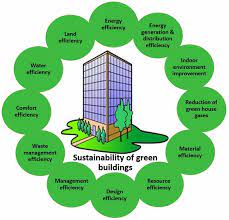Courtesy : en.wikipedia.org
Green data center
A green data center, or sustainable data center, is a service facility which utilizes energy-efficient technologies. They do not contain obsolete systems (such as inactive or underused servers), and take advantage of newer, more efficient technologies.
With the exponential growth and usage of the Internet, power consumption in data centers has increased significantly. Due to the resulting environmental impact, increase in public awareness, higher cost of energy and legislative action, increased pressure has been placed on companies to follow a green policy. For these reasons, the creation of sustainable data centers has become essential in an environmental and a business sense.
Energy use
The use of high-performance computing techniques has increased, trading energy consumption for increased performance. Industry estimates suggest that data centers consume three to five percent of the world’s global energy. According to an AFCOM State of the Data Center survey, 70 percent of data-center providers indicated that power density per rack has increased significantly since 2013. Managers have been forced to find new ways to power their data centers with renewable energy sources such as hydro,solar, geothermal, and wind. More efficient technologies were developed to decrease data-center power consumption.
Hyrdopower generator in Data Center Light, Switzerland
Metrics
Several metrics have been developed to measure power efficiency in data centers. Power usage effectiveness (PUE) and carbon usage effectiveness (CUE) are two frequently-used metrics created by the Green Grid (TGG), a global consortium dedicated to advancing energy efficiency in data centers.
Power usage effectiveness
PUE was invented in 2007, and proposed new guidelines to measure energy use in data centers.{\displaystyle \mathrm {PUE} ={{\mbox{Total Facility Power}} \over {\mbox{IT Equipment Power}}}}
This ratio describes how much extra energy a data center needs to maintain IT equipment for every watt delivered to the equipment. The best PUE a data center can have is 1: an ideal situation, with no extra energy use. When PUE was introduced, studies found that the industry-average PUE was between 2.5 and 3. In more recent studies, the average PUE fell to about 1.7 by using this framework. PUE began the shift of the data-center industry towards energy efficiency.
| PUE | 1.2 | 1.5 | 2 | 2.5 | 3 |
|---|---|---|---|---|---|
| Efficiency level | Very efficient | Efficient | Average | Inefficient | Very inefficient |
Although PUE is the most-frequently-used metric for data centers to measure energy efficiency, its reliability is still debated;
Carbon usage effectiveness
Carbon usage effectiveness (CUE) is another metric used to measure energy usage and sustainability in data centers. It is calculated with the following formula:{\displaystyle \mathrm {CUE} ={\frac {Total{\rm {{CO_{2}}EmissionsCaused}}}{ITEquipmentPower}}}
Another way to express this formula is as the product of the carbon dioxide emission factor (CEF) and the PUE, where the CEF is the kg of {\displaystyle {\ce {CO2}}}

Certifications
GGBC platinum certification
Energy Star
Data centers in the United States may apply to be certified as green data centers. The most widely used green building rating system is the Global Green Building Council (GGBC). Developed by the Global Green Building Council, it is available in several categories. Depending on ratings, data centers may receive a silver, gold or platinum certification. The platinum certification is given to data centers with the highest level of environmentally-responsible construction and efficient use of resources.
Data centers may also be certified under the National Data Center Energy Efficiency Information Program by Energy Star, part of an initiative by the U.S. Environmental Protection Agency and the U.S. Department of Energy. The program certifies buildings and consumer products for energy efficiency. Only data centers which are in the top 25 percent in energy performance may receive Energy Star certification.
Technologies
Several technologies increase efficiency and decrease energy consumption in data centers.
Low-power servers
IBM modular data center
Low-power servers are more energy-efficient than conventional servers in data centers. They use the technology of smartphone computing, which tries to balance performance with energy consumption. The first low-power servers were introduced in 2012 by large IT providers such as Dell and Hewlett-Packard. Used correctly, low-power servers can be much more efficient than conventional servers. They can have a significant impact on data-center efficiency, decreasing power consumption and the operating cost of cooling facilities.







